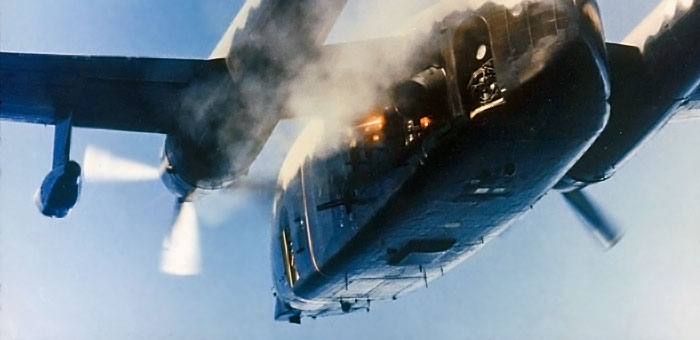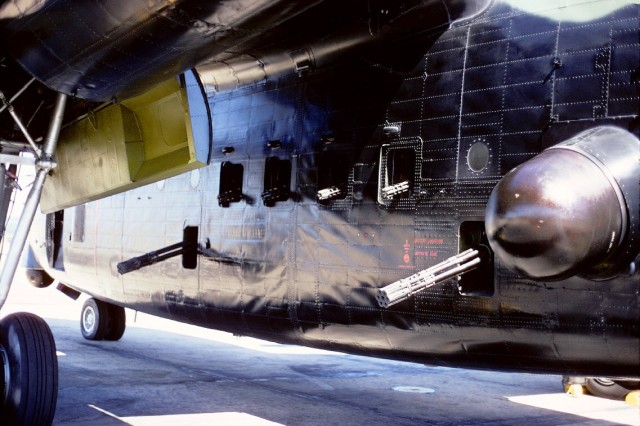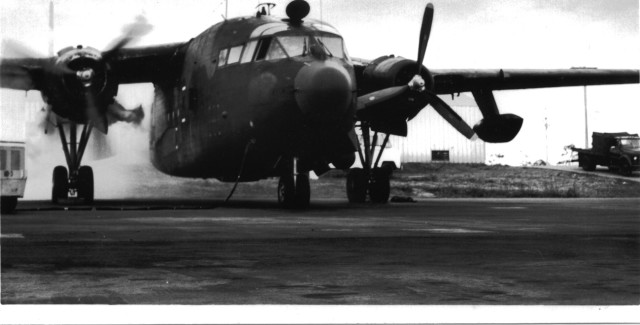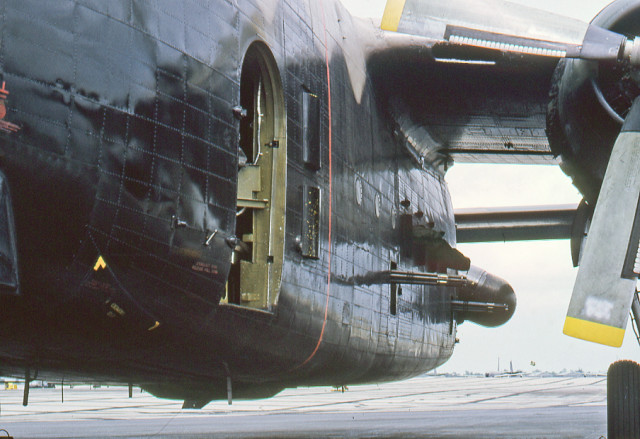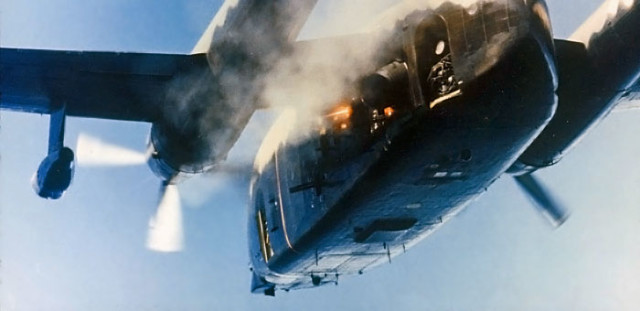 Feature Photo depicts an AC-119K Stinger while firing its array of guns in an attack on North Vietnamese trucks on the Ho Chi Minh Trail (early 1970’s). The dramatic picture gives a view of an interdiction targeting the supply lines that ran from North Vietnam via Laos to the Viet Cong forces. They must have feared and hated this aircraft. The overhead appearance and sound of this gunship’s two radial Wright R-3350’s were often the prelude to a whole lot of shaking and worse to come for those on the ground.
Feature Photo depicts an AC-119K Stinger while firing its array of guns in an attack on North Vietnamese trucks on the Ho Chi Minh Trail (early 1970’s). The dramatic picture gives a view of an interdiction targeting the supply lines that ran from North Vietnam via Laos to the Viet Cong forces. They must have feared and hated this aircraft. The overhead appearance and sound of this gunship’s two radial Wright R-3350’s were often the prelude to a whole lot of shaking and worse to come for those on the ground.
This Dakota Hunter Blog is written with a dual objective of informing you of one of the less known Gunship versions that served in Vietnam and the creation of a “Wanted” poster for the purchase of a Fairchild C-119 Flying Boxcar. Last week, I was contacted by an organisation that is about to set up a Military Aviation Museum. They are in search of two vintage Piston Prop Cargo Planes, the Douglas DC-3/ C-47/ Dakota and the C-119 Flying Boxcar that eventually will be converted to an AC-119 K Stinger version static display with the (replicated) hunter/ killer hardware of barrels and radar dome, as you can see in the picture below.
Photo above ( Courtesy Walter V. Chapman Jr.) shows fine details of the Hunter/ Killer features of the AC-119K version. In the top row, you’ll notice 4× miniguns of the type GAU-2/A 7.62 mm (0.30 in) 1,500 rounds/gun (same type as was mounted in the forerunner Gunship AC-47 Spooky). At the lower end, you see the mighty 2x M61 Vulcan 20mm Gatling cannons with 6 rotating barrels that were exclusively applied in the AC-119K version. At the right side, the huge dome houses the tracking radar, that made this Gunship so effective in search and fire guiding. Not in view in this photo are also an AVQ-8 xenon light, a night observation sight of immense light power, and an LAU-74/A flare launcher for 60x Mk 24 flares.
The AC-119K was developed under the name Project Gunship III (as a further development of the AC-47 and the Project Gunship II which was the AC-130 Hercules conversion). The gunship concept of the “First version” AC-47 had an arduous start back in 1964, with lots of initial reluctance, but soon proved to very effective in the close air support role. By 1967, the war in Vietnam was entering a new phase with a massive road transport by the enemy of materials, food, ammo, tanks, fuel by trucks over the legendary Ho Chi Minh trail via Laos to South Vietnam.
The good old Douglas AC-47 Spooky was not fit to cope with that ongoing influx, taking place too far away from their AFB. On top, their small calibre miniguns had no sufficient stopping power to keep the stream of trucks and tanks at bay. Finally, with no friendly troops/ observations on the ground, it was almost impossible to track the bandits by night, as they drove over the Trail. Therefore, the AC-119K Stinger was the first Gunship that received the special equipment to go hunt and kill the Trucks on that trail in day and night time.
In short, the AC-47 Spooky lacked the flight range, the weapons, the speed and the search equipment to go after that stealthy chain of Trucks. The underpowered WW II built AC-47 was soon to be relegated to the simpler jobs, but for an effective ‘Blockade of the Ho Chi Minh Trail”, (Viet Cong’s main supply route through Laos), they needed more punch, more range and above all, superior search/ detection equipment.
The Project Gunship II, i.e conversion of the C-130 Hercules ran dry shortly after its start, due to the very limited availability of that much wanted Cargo aircraft. Soon, the C-119 Flying Boxcar came in view as the next best choice, widely available in the Air Force reserve and with sufficient cargo space to house all the goodies needed as a Truck Killer / Trail Buster.
Photo above, The AC-119K Stinger version soon became the ideal Truck Killer/ Trail Buster. All in black, and provided with the extra General Electric J-85 turbojet engines ( you can see one slung in a pod under the wing), this Korea Veteran was filled to the brim with Top Secret Electronic Search and Fire guiding Equipment. Take a look at the non-complete list that was included in the conversion: The AN/APN-147 Doppler navigation radar, AN/AAD-4 forward-looking infrared, AN/APQ-133 side-looking beacon tracking radar and AN/APQ-136 search radar. Holy Moley, that is true Radar love!
What is now mainstream electronic equipment and in use in any serious combat aircraft, was all very advanced stuff in the late 1960’s (For more details of that, see the links at the end to my earlier 3 blogs about the 50 years Gunship History of the AC-47 Spooky and the AC-47 T Fantasma in Colombia). The Hi-Tech Search, Detection and Fire guiding package were to be mounted on a dated but sufficiently available platform of a 1940’s designed aircraft with big piston props.
Those massive Wright Duplex Cyclone R-3350’s radials were running at the end of their operational career in the USAF, being replaced more and more by the Turbo Prop engines for Cargo Planes (as with the C-130 Hercules). But with the support of the J-85’s Jet pods the max thrust came to an acceptable level for the operational purposes.
The powerful searchlight with a xenon lamp was a 20-Kilowatt, 1,5 million candlepower variable beam! As that one was switched on, it could illuminate a football stadium. Good for detecting the Bandits out there in the jungle, but also good for the Bandits to simply fire their arms at the source of that brilliant beam, not to be missed.
Therefore, we can presume that many a beam that was just switched on was rapidly switched off again! The sudden appearance of little holes in the fuselage’s outer skin is a scary experience, I guess it’ll make any operator think twice before he would switch that light on again.
Photo above: the operational career of the AC-119K Stinger was pretty short. The Stinger version was developed from the AC-119G Shadow, a more basic version made for the Electronic Counter-measures. The Fairchild -Hiller plant in Florida converted 26 of them to the AC-119 Stinger version, intentionally designed as a Truck Hunter.
The first Stinger version flew in December 1969 with 18th Special Operations Squadron. While the AC-119G Shadow was inactivated in 1971, there was a limited number of AC-119K Stingers that operated from Thailand as late as the fall of 1972. But shortly after, all AC-119’s were to be phased out from USAF service.
Only a few of them continued to fly in the South Vietnam Air Force (VNAF) until the very end in 1975, as South Vietnam fell. During the active military career of 3 years in USAF service, only 5 AC-119’s were lost to a variety of causes, that is a very acceptable score for a relatively slow and low flying aircraft that entered the battle zone so many times. With a very determined enemy, well armed in the final phase of that war, it is amazing that the Viet Cong was not able to shoot down more gunships that were orbiting overhead like frenzied hornets.
The Museum display aircraft that we look for is actually a tribute to the flight crews, their mechanics and to the ruggedness of this aircraft that they could keep the damage to their flying boxcars (what’s in a name) so limited, bravo!
Having said that, back to the title of this blog post: Wanted for a new Military Aviation Museum, a Flying Boxcar. We’ll seriously consider the offers that can lead to the purchase a Dakota/ DC-3/ C-47 (flying or non-flying) and a C-119 (for static display only, to be “cosmetically” converted to a Stinger configuration). I am overseeing the procurement of these both aircraft that should lead to the purchase and overseas transport to the military museum of a US ally that had the aircraft operational in its own Air Force.
If you have a clue or information that can lead me to one or both aircraft wanted, in a state (and price brackets) that convenes the client’s requirements/ budget, you please contact me via my website dc3dakotahunter.com . I know there sit for years 2 C-119’s on Palmer Airport, in Alaska and there is one C-119 for sale in Lancaster, California in the Milestones of Flight Museum. So far, I was not able to contact the owners (they operate under the radar of internet, or are closed?) so if you might have a lead to one of those or any other C-119 for sale, contact me.
If that info would eventually lead to a deal, I owe you a signed free copy of my book The Dakota Hunter AND the Commemorative Plaque of the “DC-3 80 Years Maiden flight” which will soon come for sale (see final picture below). The Plaque is an authentic piece of fuselage skin of a C-47 Skytrain. This panel is recovered from an aircraft, that is very well documented from its birth in the Douglas Oklahoma Plant in 1944 to its final disassembly in 2013.
I bought the airframe in 2012 and still own the fuselage components of which this unique Commemorative Plaque is made. Therefore, the plaque comes with a Certificate of Authenticity, delivered and signed by the Dakota Hunter. Soon available in Limited series, this genuine skin panel of a War Bird with a Photo at choice, as depicted in the picture below, comes for sale. If interested, please contact me for more information at my website.
Stay tuned for more news and blogs to follow soon, next week with a first The Dakota Hunter Video titled
Last flight over Lake Titicaca, a dramatic video report of the “Tragic end of the last Bolivian Curtiss Commando C-46”.
Enjoy and see me also on facebook, Best Hans Wiesman/ The Dakota Hunter.
Related Dakota Hunter blog posts about Gunships,
50 years of C-47 Gunship conversions, from Vietnam to Colombia!
Spooky in Combat role, 80 Years after the DC-3 Maiden Flight!
